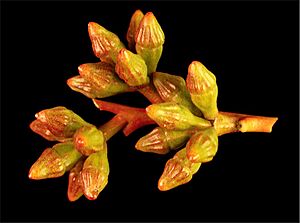Balladonia gum facts for kids
Quick facts for kids Balladonia gum |
|
|---|---|
 |
|
| Eucalyptus fraseri growing near Balladonia | |
| Scientific classification | |
| Genus: |
Eucalyptus
|
| Species: |
fraseri
|
| Synonyms | |
|
Eucalyptus conglobata subsp. fraseri Brooker |
|
The Eucalyptus fraseri, commonly called Balladonia gum, is a type of tree or a "mallet." A mallet is a tree that grows tall but doesn't have a special woody lump at its base called a lignotuber. This tree is found only in Western Australia. It has smooth bark that is white to grey. This bark often peels off in long strips. The leaves are shaped like a spear or are slightly curved. Its flower buds grow in groups of seven or nine, and the flowers are white. After flowering, it produces fruit that looks like a cup or cone.
What it Looks Like
The Balladonia gum is a tree or a mallet that usually grows between 5 and 20 metres (about 16 to 65 feet) tall. It has smooth bark that is white or grey. This bark peels off in ribbons. Sometimes, near the bottom of the tree, the bark can be rough and dark.
Young plants and new shoots that grow from a cut or damaged tree (called coppice regrowth) have dull, bluish-green leaves. These leaves are egg-shaped, about 7.5 to 10.5 centimetres (3 to 4 inches) long and 3.5 to 6.5 centimetres (1.4 to 2.6 inches) wide. They have a stalk, or petiole, that connects them to the stem.
Older leaves are shiny green on both sides. They are shaped like a spear or are slightly curved. These adult leaves are about 9 to 17 centimetres (3.5 to 6.7 inches) long and 1.3 to 3.5 centimetres (0.5 to 1.4 inches) wide. Their stalks are about 1.5 to 3.3 centimetres (0.6 to 1.3 inches) long.
The flower buds grow in the axils of the leaves. An axil is the angle between a leaf and the stem. The buds are found in groups of seven or nine. They grow on a thick, unbranched stalk called a peduncle, which is about 5 to 10 millimetres (0.2 to 0.4 inches) long. Each individual bud might sit directly on the peduncle (sessile) or have a very short stalk of its own (a pedicel) up to 3 millimetres long.
Mature buds are oval-shaped, about 10 to 15 millimetres (0.4 to 0.6 inches) long and 6 to 7 millimetres (0.2 to 0.3 inches) wide. They have a cone-shaped cap called an operculum, which often has stripes. The Balladonia gum flowers between January and March or April. Its flowers are white.
The fruit is a hard, woody capsule. It can be cup-shaped, cone-shaped, or half-sphere shaped. The fruit is about 7 to 11 millimetres (0.3 to 0.4 inches) long and 7 to 10 millimetres (0.3 to 0.4 inches) wide. The parts that open to release the seeds (called valves) are usually close to the rim of the fruit.
How it was Named
The Balladonia gum was first officially described in 1972 by a botanist named Ian Brooker. He wrote about it in a science journal called Nuytsia. At first, he named it Eucalyptus conglobata subspecies fraseri. Brooker found the very first plant specimen (called the type specimen) near a place called Balladonia.
Later, in 1976, Brooker decided that this plant was different enough to be its own species. So, he changed its name to Eucalyptus fraseri. The second part of the name, fraseri (called the specific epithet), was chosen to honour Sir Malcolm Fraser. He was the Surveyor General of Western Australia from 1872 to 1883.
In 2001, two other botanists, Lawrie Johnson and Ken Hill, described two slightly different types of Eucalyptus fraseri. These are called subspecies. Both of these subspecies are now officially recognised:
- Eucalyptus fraseri subspecies fraseri: This type has smooth bark all the way up its trunk.
- Eucalyptus fraseri subspecies melanobasis L.A.S.Johnson & K.D.Hill: This type has a thick, hard, black bark on the lower 1.5 to 4 metres (about 5 to 13 feet) of its trunk.
Where it Grows
The Balladonia gum grows in open shrubland areas. You can find it on flat plains, low sand dunes, and hilly regions. It grows between the towns of Norseman, Scaddan, and Balladonia. It prefers to grow in soils that are rich in lime (called calcareous loam) or sandy soils that are found over limestone. The subspecies melanobasis is found only in the higher parts of the Fraser Range.
Conservation Status
The subspecies fraseri is currently considered "not threatened." This means there are enough of these trees, and they are not in danger of disappearing.
However, the subspecies melanobasis is classified as "Priority Two" by the Western Australian Government's Department of Parks and Wildlife. This means that not much is known about this subspecies, and it has only been found in one or a few places. It needs to be watched carefully to make sure it stays safe.



